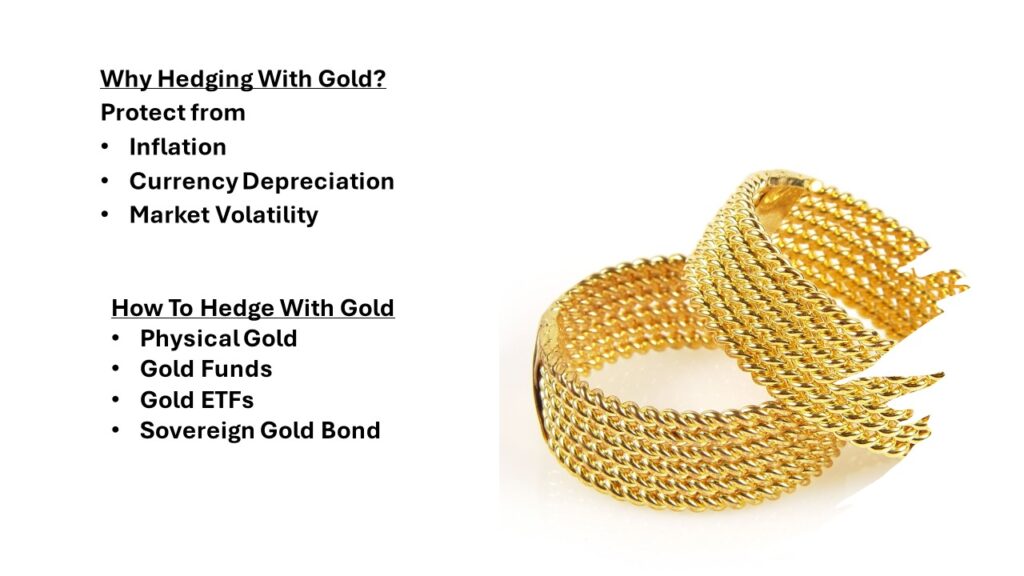Gold has been a symbol of wealth and a way to save money for thousands of years. It has special qualities that make it a popular choice for people who want to protect their investments from risks. In this easy-to-understand guide, we’ll talk about how gold investment can help keep your money safe. We’ll also look at the benefits of gold funds and ETFs. Finally, we’ll show you how to add them to a well-rounded investment plan.

Understanding Hedging and Its Importance
Hedging is a way for investors to protect their money from losing value when the market doesn’t go their way. It’s like having a backup plan. When you hedge, you invest in different things that are likely to move in opposite directions. For example, if you buy Stock A and also invest in a gold fund, you have a hedge. If Stock A goes down in value, the gold fund might go up, balancing things out. The main idea behind hedging is to lower the chances of losing money rather than trying to make the most money possible.
Hedging is crucial for several reasons:
Risk mitigation
It is like having a safety net for your investments. It helps keep your money safer when the market isn’t doing well. By putting your money into different types of investments, you’re less likely to lose a lot if one of them goes down. For example, if the stock market drops, other things like bonds or gold might stay steady or even go up. This way, your whole investment plan stays more balanced, even when things get rough.
Portfolio Stability
Hedging helps keep your investments more steady, so they don’t bounce up and down too much over time. One way to do this is by adding gold to your investment mix. Gold usually behaves differently from stocks, so when the stock market is a bit crazy, gold can help balance things out. This way, your investments don’t lose as much value when things get unpredictable, making it a smarter way to protect your money.
Preservation of Capital
Preservation of capital is all about keeping your money safe. Hedging helps by cutting down losses when the market isn’t doing great. Instead of putting all your money in one place, you spread it out across different investments. If one of them loses value, others might stay steady or even go up. This way, you don’t lose as much of what you’ve saved. It helps you keep more of your money safe over time.
Why Hedging With Gold Investment Is Effective
Gold is considered an effective hedge for the following :
Inflation Protection:
Inflation protection is all about making sure your money can still buy what you need, even when prices go up. Gold is good for this because it usually holds its value or even gets more valuable during inflation. When the value of regular money goes down, gold often stays the same or goes up. This helps you keep your buying power strong. That’s why gold can be a smart choice if you’re worried about inflation cutting into your savings.
Currency Depreciation
Currency depreciation is when the value of regular money, like dollars or rupees, goes down. When this happens, people often turn to gold because it’s seen as a safer choice. Unlike paper money, gold doesn’t lose its value as easily. So, when money starts losing its worth, gold usually goes up. That’s why holding gold can be a smart way to protect your savings. It helps keep your money safe, especially when regular money isn’t worth as much.
Market Volatility
Market volatility is when prices in the stock market bounce up and down a lot. It makes it hard to know what’s coming next. But during these uncertain times, gold usually does well. People see it as a safe place to invest. Plus, when there’s geopolitical instability, like conflicts between countries, gold tends to hold its value or even go up. That’s why gold is a smart choice when other investments seem too risky. By investing in gold, you can help protect your money when the market is all over the place.
Diversification
Diversification is important because it helps spread your investments around to reduce risk. Gold is perfect for this because it doesn’t move the same way as other assets, like stocks or bonds. So, when stocks go down, gold might stay the same or even go up. This helps keep your overall investments balanced. Plus, since gold doesn’t follow the same trends as other assets, it adds extra protection. By adding gold to your portfolio, you’re less likely to lose money all at once. It’s like having a safety net that keeps your investments steady.
Options of Gold Investment
There are several ways to invest in gold, each with advantages and disadvantages. You can use physical gold, Gold Funds, Gold ETFs, and sovereign-gold bonds. Here is a table of the different gold investment options:
| Investment Type | Description | Pros | Cons |
| Physical Golds | Includes gold bars, coins, and jewelry. | Tangible asset, no counterparty risk. | Involves storage and insurance costs, and the risk of theft. |
| Gold Funds | Invests in gold-related assets, such as gold mining companies. | Subject to fund management fees, and indirect exposure to gold prices. | Subject to fund management fees, and indirect exposure to gold prices. |
| Gold ETFs | Exchange-traded funds that track the price of gold and trade like stocks on an exchange. | Liquidity, low expense ratios, no physical storage needed. | May involve brokerage fees, and price tracking errors. |
| Sovereign Gold Bond | Bonds issued by the Indian government that offer a fixed interest rate and can be redeemed at the prevailing gold price. | Government-backed security, interest income, capital appreciation potential. | Professional management, and diversified exposure to gold-related assets. |
Strategy To Hedge With Gold Investment
Incorporating gold into a portfolio requires a strategic approach to maximize its hedging benefits:
Determine the Allocation
Figuring out how much gold to add to your portfolio is important. First, think about how much risk you’re okay with. You should also consider your investment goals. For example, if you’re more cautious, you might want to go closer to 10% in gold. Plus, don’t forget to look at the market outlook. If things seem uncertain, putting more in gold might be a good idea. A common recommendation is to put 5-10% of your portfolio in gold. This way, you can protect your investments while still leaving room for growth.
Choose the Right Instrument
Choosing how to invest in gold depends on what feels right for you. If you like having something you can actually hold, physical gold like coins or bars might be the way to go. But, keep in mind, you’ll need a safe place to store it. On the other hand, gold funds and gold ETFs are easier to buy and sell. Plus, you don’t have to worry about storage. However, these options do come with management fees and might not feel as personal as owning physical gold. Each choice has its ups and downs, so pick the one that fits your needs best.
Monitor Market Conditions
Keeping an eye on market conditions is really important for making good decisions with your gold investments. First, watch economic indicators like interest rates and unemployment because these can affect gold prices. Inflation trends are also something to pay attention to since gold often goes up when inflation rises. Plus, don’t forget to keep track of geopolitical events, like conflicts or political instability. These can make people turn to gold for safety. By staying informed, you’ll be ready to adjust your gold investments when needed.
Rebalance Regularly
Rebalancing regularly is key to keeping your portfolio in good shape. Over time, the value of your gold investments might change compared to your other assets. This can mess up the balance you wanted. For example, if gold prices go up, you might end up with more gold than you planned. So, by checking and adjusting your investments, you can get everything back on track. This way, your portfolio stays balanced and matches your goals.
Case Study: Hedging with Gold During Market Crises
Looking at history can help us understand how gold works as a safety net for investments:
2008 Financial Crisis: During the global financial crisis, gold prices shot up because investors were looking for safe places to put their money. Portfolios that included gold didn’t lose as much value as those without it.
COVID-19 Pandemic: The uncertainty and economic disruption caused by the pandemic also led to a big increase in gold prices. People turned to gold as a safe place to keep their money when the market was all over the place.
Potential Risks and Considerations while hedging with gold
While gold has a lot of benefits as a safety net for your investments, there are some risks to think about too. Here are a few things you should keep in mind when using gold as a hedge.
Price Volatility
Price volatility means that gold prices can jump up and down a lot in a short time. This can happen for a few reasons. First, changes in interest rates can cause prices to shift. Also, how strong different currencies are can play a role. Plus, how people feel about the economy—called market sentiment—can make gold prices change quickly. So, while gold is a good long-term investment, you should be ready for its value to bounce around in the short term. This means you might see some big swings in the price before it settles down.
No Yield
Gold doesn’t give you income like stocks or bonds. For example, it doesn’t pay dividends or interest. Instead, you make money from gold when its value goes up over time. So, if gold prices increase, you can make a profit when you sell it. However, if gold prices drop, you might lose some of your investment. That’s why, while gold can help protect against other risks, it doesn’t provide regular income.
Storage and Insurance Costs
When you invest in physical gold, you need to think about storage and insurance. First, you’ll need a secure place to keep your gold, which usually means paying for a safe storage facility. Also, it’s important to get insurance to protect your gold from theft or damage. This extra protection adds to your overall costs. So, while gold can be a good investment, don’t forget that storage and insurance can make it more expensive.
Market Timing
Market timing is super important when using gold as a hedge. For instance, if you buy gold when prices are really high, you might not get the full benefits. That’s because you could end up paying more than you should if the prices don’t go up much more. Instead, it’s better to buy gold when prices are lower. This way, you have a better chance of making a good return and getting the most from your investment.
Conclusion
Hedging with gold, using gold funds and ETFs, is a smart way to protect and diversify your portfolio. Gold is special because it helps guard against things like inflation, currency changes, and market ups and downs. By understanding both the benefits and risks of investing in gold, you can make your portfolio stronger and better for the long term. For example, putting 5 to 10% of your portfolio in gold is a good strategy. This helps create a safety net against different financial uncertainties, making your overall investment plan more balanced and secure.

